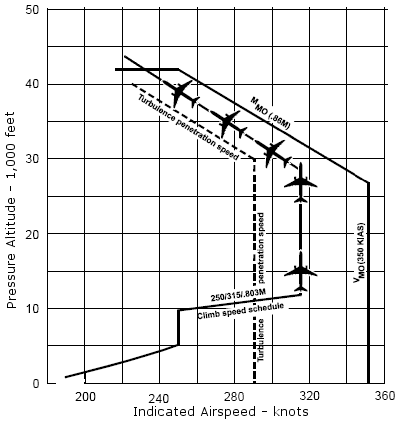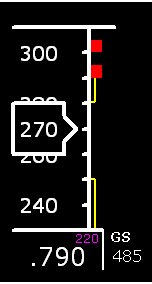Vmo/Mmo Limitations Review
Boeing From time to time, we have received inquiries from pilots on what defines Vmo/Mmo on a jet transport, how it is displayed on the Mach/Airspeed Indicator, and its behaviour with changing altitude. We will devote this issue to a review of Vmo/Mmo, from the pilot’s perspective.
As defined by FAR 25.1505, Vmo/Mmo is the “Maximum Operating Limit Speed that may not be deliberately exceeded in any regime of flight (climb, cruise, or descent) except where a higher speed is authorised for flight test or pilot training operations”.
All Boeing airplanes are certified to this rule. Therefore, intentional exceedance of Vmo/Mmo is not permitted in normal operations. Exceeding Vmo/Mmo can pose a threat to exceeding design structural integrity and design stability & control criteria of the airplane. At speeds less than Vmo/Mmo the airplane’s flight characteristics have been confirmed by flight testing to meet FAR requirements. At speeds in excess of Vmo/Mmo, however, normal airplane handling characteristics are not assured.
Vmo/Mmo is displayed by the Vmo pointer on the conventional round dial Mach/Airspeed Indicator, and by the lower boundary of a red/black striped barber pole on vertical tape airspeed indicators. There is no separate pointer for Mmo. Mmo information is combined electronically into the Vmo pointer such that the pointer will always point to either the Vmo speed or the Mmo speed, whichever is slower, to protect the airplane from speed exceedance. Vmo/Mmo on the vertical tape airspeed indicators uses the same computational logic as that used by the Vmo pointer. Exceeding either Vmo or Mmo will result in the activation of an aural warning (clacker).
 As an example, the diagram shows the flight envelope for the 757-200. Notice that below approximately FL270, the airplane is Vmo restricted to 350 KIAS. Above approximately FL270, the airplane is Mmo restricted to 0.86 Mach. Therefore, 350 KIAS/0.86M defines Vmo/Mmo for this airplane respectively. Other Boeing models have different Vmo/Mmo values, but the shape of the basic flight envelope remains unchanged from model to model.
As an example, the diagram shows the flight envelope for the 757-200. Notice that below approximately FL270, the airplane is Vmo restricted to 350 KIAS. Above approximately FL270, the airplane is Mmo restricted to 0.86 Mach. Therefore, 350 KIAS/0.86M defines Vmo/Mmo for this airplane respectively. Other Boeing models have different Vmo/Mmo values, but the shape of the basic flight envelope remains unchanged from model to model.
FMC speed schedules are pre-programmed (as a function of Cost Index) to follow the shape of the flight envelope during climb/cruise/descent while staying a fixed speed margin away from the Vmo/Mmo envelope boundary.
The corresponding Mach/Airspeed Indicator display for a typical climb to altitude is shown in Figure 1. As the airplane climbs, the Vmo pointer will essentially trace the Vmo/Mmo boundary as a function of airplane altitude. This is the reason the Vmo pointer (or the barber pole boundary) will remain fixed at Vmo (350 KIAS for the 757) while climbing from Sea Level to FL270. At approximately FL270, the Vmo pointer will begin to move off 350 KIAS to restrict maximum IAS to a lower speed corresponding to the slanted “constant Mach” portion of the flight envelope. By FL390, the Vmo pointer will be pointing at 269 KIAS, an 81 kt reduction in “permissible” indicated airspeed from 350 KIAS. During descent, the Vmo pointer will move in reverse of the climb, arriving back at 350 KIAS at approximately FL270 and staying there for the remainder of the descent.
Mmo: CAA versus FAA

The Boeing 767 has a Maximum Dive Mach Number (Md) of 0.91. For certification, the FAA and CAA apply different methods when determining the aircraft's Maximum Cruise Mach Number (Mmo):
FAA
For the FAA, Mc must not be greater than Md - 0.05M.Thus for FAA certified aircraft, the Boeing 767 has a maximum cruise mach number (Mmo) of 0.86M. (Md minus 0.05)
CAA
However, for CAA certified aircraft, the margin between Mc and Md must allow the aircraft to encounter a head-on gust of 45 ft per sec, without exceeding Md, at the lowest altitude (25,000 ft) where Vmo and Mmo are coincident. At the declared altitude of 25,000 ft, 45 ft per sec equates to 0.07M.Thus for CAA certified aircraft, the Boeing 767 has a Maximum Cruise Mach Number (Mmo) of 0.84M (Md minus 0.07).
Buffet Margin
The FAA and CAA specify buffet limited altitudes differently:
FAA
The FAA do not stipulate a minimum manoeuvre margin to buffet, but Boeing use 0.3g. The calculation assumes a typical in-service CG of 25% MAC. If the actual CG is forward (less than) 25%, the actual margin to buffet will be slightly less than 0.3g.CAA
The CAA require a 0.3g minimum manoeuvre margin to buffet, but based on the more conservative CG of 7% MAC (forward limit of flight envelope). At normal operating cruise CG's around 20, this results in a reduction of maximum cruise altitude capability of up to 1,000 ft.
Boeing Flight Operations Review 757-27, 8th January 1999